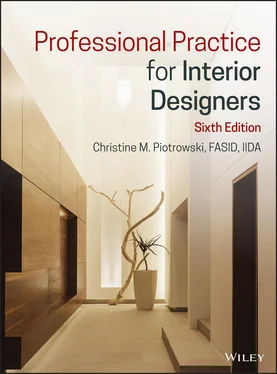Christine M. Piotrowski - Professional Practice for Interior Designers
Здесь есть возможность читать онлайн «Christine M. Piotrowski - Professional Practice for Interior Designers» — ознакомительный отрывок электронной книги совершенно бесплатно, а после прочтения отрывка купить полную версию. В некоторых случаях можно слушать аудио, скачать через торрент в формате fb2 и присутствует краткое содержание. Жанр: unrecognised, на английском языке. Описание произведения, (предисловие) а так же отзывы посетителей доступны на портале библиотеки ЛибКат.
- Название:Professional Practice for Interior Designers
- Автор:
- Жанр:
- Год:неизвестен
- ISBN:нет данных
- Рейтинг книги:4 / 5. Голосов: 1
-
Избранное:Добавить в избранное
- Отзывы:
-
Ваша оценка:
- 80
- 1
- 2
- 3
- 4
- 5
Professional Practice for Interior Designers: краткое содержание, описание и аннотация
Предлагаем к чтению аннотацию, описание, краткое содержание или предисловие (зависит от того, что написал сам автор книги «Professional Practice for Interior Designers»). Если вы не нашли необходимую информацию о книге — напишите в комментариях, мы постараемся отыскать её.
Professional Practice for Interior Designers
Professional Practice for Interior Designers — читать онлайн ознакомительный отрывок
Ниже представлен текст книги, разбитый по страницам. Система сохранения места последней прочитанной страницы, позволяет с удобством читать онлайн бесплатно книгу «Professional Practice for Interior Designers», без необходимости каждый раз заново искать на чём Вы остановились. Поставьте закладку, и сможете в любой момент перейти на страницу, на которой закончили чтение.
Интервал:
Закладка:
After World War II, nonresidential design became an increasingly important aspect of the profession for many reasons. The evolution of giant corporations was one factor. Curtain wall construction, suspended ceilings, and changes in construction to allow for vast, open interior spaces in office buildings all affected the design–build industry. Changes in the philosophy of the workplace created new furniture concepts, such as that of the “office landscape.” As companies embraced this planning philosophy, new specialists in space planning, lighting design, and acoustics became part of the profession.
Commercial interior design was making an impact on the profession from a business standpoint as well. Some refer to commercial interior design as nonresidential or contract interior design. The term contract design grew out of early commercial design from the fact that commercial projects more frequently were executed based on contracts for services. Of course, both residential and commercial projects are undertaken after a contract for services has been executed in today's professional practice.
Women were making an impact on the commercial design industry as well. Dorothy Draper (1889–1969) is credited with being the first woman interior decorator who specialized in commercial interiors. 13Florence Knoll established the Knoll Planning Group in the 1940s. This design company's focus was on commercial interior design. 14
New design concepts, as well as other issues, created tension and arguments over educational requirements and admission to professional associations for interior designers. A renewed debate ensued over the words “decorator” versus “designer.” As educational programs developed, curriculums varied, resulting in uneven preparation. It was recognized that education needed to be more stringent, with formalized preparation that went beyond aesthetics. The growing complexity of the work of the interior designer led to professional associations formalizing requirements for membership.
Major impacts on the interior design profession have been the increased availability to technology and globalization of business to enhance the work of a design professional. The technology of the Internet has given professionals the opportunity to market their services on a global scale. Although large firms have had the opportunity to be multinational for many years, now a potential client in a foreign country can discover even a sole practitioner in another country.
Embracing technology gives any size design firm many advantages. Designers now have the opportunity to search out products outside their immediate market area. Technology also allows for rapid production of design documents, and easy communication throughout the world.
The profession thrives during economic booms and, like every industry, redefines itself when the economy is slow. Regardless of the impact of the economy, interior design professionals and students will be faced with continuous change in the profession. Finding one's way by gaining education, experience, and competency to work as a professional interior designer in the 21st century includes achieving knowledge and skills in professional practice.
New pressures and responsibilities will continue to affect all practitioners, businesses, and even students of interior design. This short history provides a context for the development of the interior design profession and is meant to give readers an appreciation of the roots of the profession called interior design. Table 1‐1summarizes its chronological development. Additional history of the associations is presented later in Chapter 2.
INTERIOR DESIGN VALUE
“I don’t understand why you charge so much!”
Most interior designers have, at one time or another, heard this comment from clients. Many professionals are stumped as to how to respond to this statement. Professionals and the profession still must combat the undervaluing of interior design services.
TABLE 1‐1. Highlighted chronology of the growth of the interior design profession
| 1878 | First‐of‐its‐kind semiannual furniture market. Held in Grand Rapids, Michigan. |
| 1904 | First real use of term interior decoration. First courses in interior decoration offered at the New York School of Applied and Fine Arts. |
| 1905 | Elsie de Wolfe obtains her first commission as an interior decorator. She is credited with being the first interior decorator. |
| 1913 | Elsie de Wolfe publishes the first true book on interior decoration, The House in Good Taste . |
| 1920s | Greater effort is made by department stores to market home furnishings. Manufacturing centers of home furnishings begin to develop. Art Deco period creates greater interest in interior decoration of homes and offices. Dorothy Draper credited with being the first woman interior decorator to specialize in commercial interiors. Decorator clubs begin forming in larger cities. Design education strengthened in many parts of the country. |
| 1931 | Grand Rapids furniture show. Meeting to create a national professional organization. In July, American Institute of Interior Decorators (AIID) is founded; William R. Moore elected first national president of AIID. |
| 1936 | AIID's name changed to American Institute of Decorators (AID). |
| 1940s | Post‐World War II industrialism encourages new technologies in furniture manufacturing. Industrialism produces increased need for, and importance of, nonresidential interior design. |
| 1950s | Development of open landscape planning concept in Germany by Quickborner Team. |
| 1951 | First time a state considers legislation to license interior design. |
| 1957 | National Society for Interior Designers (NSID) founded from a splinter group of the New York AID chapter. |
| 1961 | AID changes its name to American Institute of Interior Designers (AIID). |
| 1963 | National Office Furnishings Association (NOFA) creates NOFA‐d (NOFA‐designers), a professional group for interior designers who work for office furnishings dealers. Interior Design Educators Council (IDEC) founded to advance the needs of educators of interior design. |
| 1967 | NOFA and NOFA‐d change names to NOPA and NOPA‐d, respectively, when NOFA merges with stationery and supplies dealers to form National Office Products Association. |
| 1968 | Introduction of “Action Office,” designed by Robert Probst for Herman Miller, Inc. First true open‐office furniture product. |
| 1969 | Institute of Business Designers (IBD) incorporated. NOPA‐d is parent organization. |
| 1970 | Charles Gelber elected first national president of IBD. Foundation for Interior Design Education Research (FIDER) is founded. Is responsible for reviewing and accrediting undergraduate and graduate interior design programs. |
| 1972 | CIDQ (Council for Interior Design Qualification) formed. It is responsible for the development of the NCIDQ examination. |
| 1974 | National Council for Interior Design Qualification (NCIDQ) incorporated. Charged with the development and administration of a common qualification examination. Louis Tregre, FAID, serves as first president of NCIDQ. |
| 1975 | American Society of Interior Designers (ASID) formed from the merger of AID and NSID. Norman deHaan is first national ASID president. |
| 1976 | The first Canadian provincial associations—Interior Designers of Ontario and the Interior Designers of British Columbia—were admitted as members of NCIDQ. |
| 1982 | Alabama becomes first state with title registration legislation for interior design. |
| 1988 | First major discussion of 1995 Hypotheses, the document that begins a discussion of unification of interior design professional associations. |
| 1992 | Passage of Americans with Disabilities Act (ADA), which establishes accessibility standards for all public buildings. |
| 1993 | U.S. Green Building Council formed to promote sustainable design. |
| 1994 | Unification of IBD, ISID, and CFID to form International Interior Design Association (IIDA). The existing code councils form the International Code Council (ICC) to develop a new universal standard of building codes. |
| 1995 | First International Code from the ICC is published. |
| 1996 | Federal government officially recognizes interior design as a profession. |
| 1990s | Numerous states pass title, practice, or certification legislation. |
| 2000 | ASID and IIDA leadership begins discussions concerning potential merger. Talks discontinued in 2002. |
| 2002 | ASID and the Government Services Administration (GSA) sign an agreement to promote interior design excellence in federal buildings. |
| 2003 | InformDesign® is initiated as a Web site to locate and make available research on interior design practices. |
| 2006 | The Council for Interior Design Accreditation (CIDA) replaces FIDER as the accrediting group for interior design education. |
| 2010 | Update and revision of the Interior Design Body of Knowledge. |
| 2011 | Regulation and licensing continue to be sought after for the profession. IDCEC becomes an independent organization to coordinate continuing education offerings. |
| 2017 | NCIDQ examination begins being offered electronically. |
Unfortunately, many clients still view interior design services as “fun” and “easy” and more “creative” than business. Because they see so many shows on television that seems to make doing interiors easy and fast, they lack appreciation for the profession. Added to this is the fact that designers do not communicate how interior design can be of value to clients so that the client questions the designer’s suggestions and fees.
Читать дальшеИнтервал:
Закладка:
Похожие книги на «Professional Practice for Interior Designers»
Представляем Вашему вниманию похожие книги на «Professional Practice for Interior Designers» списком для выбора. Мы отобрали схожую по названию и смыслу литературу в надежде предоставить читателям больше вариантов отыскать новые, интересные, ещё непрочитанные произведения.
Обсуждение, отзывы о книге «Professional Practice for Interior Designers» и просто собственные мнения читателей. Оставьте ваши комментарии, напишите, что Вы думаете о произведении, его смысле или главных героях. Укажите что конкретно понравилось, а что нет, и почему Вы так считаете.












